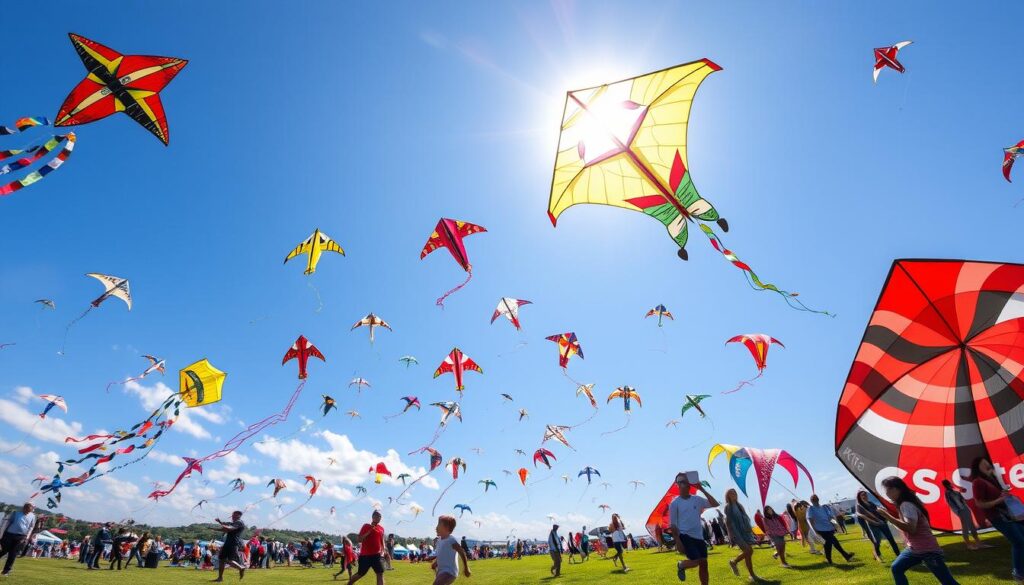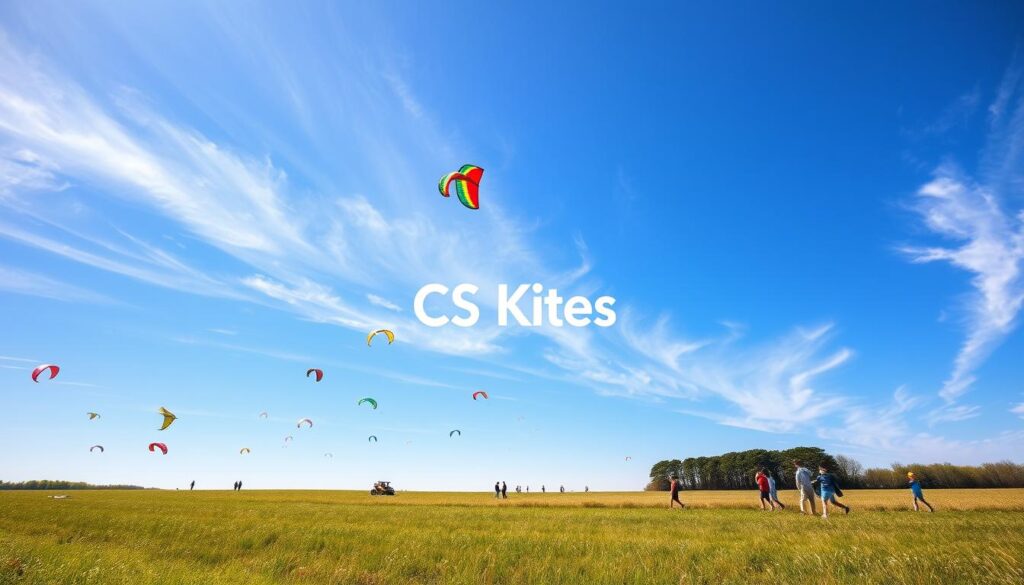Ever wondered the best time to fly a kite? I’m here to share the secrets of kite flying conditions. As Leonardo da Vinci said, “Once you have tasted flight, you will forever walk the earth with your eyes turned skyward.” Let’s find out when to fly high!
Kite flying is fun for everyone. It doesn’t matter if you’re new or experienced. Knowing the right conditions is crucial for a great flight. Most kites do well in breezes of 4-10 miles per hour. If you feel a gentle breeze, it’s kite flying time.
When picking a flying spot, think about the wind. Stay away from things that could mess with your kite’s flight. For safety, avoid flying in strong winds that can harm your kite.
Newbies should start with simple kites. They’re easy to use and perfect for beginners. As you get better, you can try more complex kites.
Key Takeaways
- Ideal wind speed for kite flying is between 4-10 miles per hour
- Choose open spaces to avoid turbulence from obstacles
- Beginners should start with simple single-line kites
- Avoid flying in harsh winds or stormy conditions
- Kite flying is enjoyable for all age groups
- Understanding wind conditions is crucial for a successful flight
Understanding the Benefits of Kite Flying
Kite flying is great for both newbies and experts. It offers many benefits. I’ll share some tips to make your kite flying better.
A Connection to Nature
Flying a kite helps us connect with nature. It lets us enjoy the outdoors, feel the wind, and watch the sky. This can lower stress, anxiety, and depression.
Physical Health Benefits
Kite flying is good exercise for everyone. It involves walking and sometimes running to get the kite up. This stretches your spine, neck, and shoulders.
It also helps your eye muscles, reducing fatigue from screens.
Mental Well-Being Through Play
Flying a kite boosts creativity and reduces stress. It teaches you to adapt to wind changes, improving problem-solving. For beginners, it’s a fun mental challenge.
Studies show 87% of people find kite flying increases their creativity and design thinking.
| Benefit | Percentage Improvement |
|---|---|
| Stress Reduction | 78% |
| Creativity Boost | 87% |
| Anxiety Reduction | 53% |
| Hand-Eye Coordination (Children) | 45% |
Kite flying is rewarding for all. Whether you’re new or experienced, seeing your kite fly high brings joy and peace.
Ideal Weather Conditions for Kite Flying
Wondering when to fly a kite? The right weather is crucial for a fun kite flying session. Knowing about wind, seasons, and weather helps a lot.
Wind Speed Requirements
The best wind speed for kite flying is between 6 to 22 mph. Beginners should start with winds of 5 to 7 knots. Here’s a guide for different kite sizes:
| Kite Size | Minimum Wind Speed |
|---|---|
| 17 sqm | 8-10.8 knots |
| 11 sqm | 13.2-17 knots |
Best Seasons for Flying Kites
In the Inland Northwest, March and April are great for kite flying with winds around 9 mph. Summer months like August and September have milder winds, about 5.5 mph. For windier spots, Chicago (10.3 mph) and Dodge City, Kansas (13.3 mph) are good choices.
Avoiding Rain and Thunderstorms
Kite flying is possible all year, but avoid flying in rain or thunderstorms. Always check the weather forecast first. If the wind is too light or too strong, it’s best to wait, even for beginners.
“The wind and the kite are dance partners, and knowing when to join their waltz is the key to a magical flight.”
Remember, kite flying conditions change with location and season. By understanding these, you’ll know the best time to fly your kite.
Traditional Kite Flying Events in China
China’s kite flying tradition is rich and vibrant. Its festivals and events are among the best kite flying locations worldwide. They offer a unique mix of culture and skill.
Local Festivals Celebrating Kite Flying
The Weifang International Kite Festival is a top event. It takes place from April 20th to 25th in Weifang, Shandong Peninsula. Kite lovers from all over come to see it.
This festival celebrates China’s kite flying history. It goes back to the Warring States Period (475-221 B.C.).
Community Gatherings and Kite Competitions
Kite festivals in China are more than flying kites. They celebrate history, art, and community. Weifang village is known as the “world capital of kites.”
Kite making there is a national-level intangible cultural heritage. The festivals feature large kites up to 304 meters and small ones as small as 30 centimeters.
“Kite flying brings people together, bridging cultures and generations through a shared love of the sky.”
Competitions at these festivals show off kite designs and flying skills. Participants can learn from experts. They dive into the cultural side of Chinese kite flying.
The 41st Weifang International Kite Festival had over 460 participants from 46 countries. It shows how these events attract people worldwide.
The Importance of Choosing the Right Kite
Finding the right kite is crucial for a great flying experience. CS Kites has a wide range of kite shapes and designs for everyone. Whether you’re a pro or a beginner, knowing what to look for is essential.
Types of Kites Available
Our collection includes kites for all skill levels and wind conditions. Beginners should start with larger kites that are easy to handle. For those with more experience, sport kites or LED kites for night flying are great options.
Recommendations for Novices
New to kite flying? Try a diamond or delta kite. They’re stable and easy to learn with. Plus, kite flying is a fun way to get some exercise, burning up to 100 calories in 30 minutes!
Factors in Kite Selection
When picking a kite, keep these points in mind:
- Wind conditions: Each kite works best in certain winds
- Kite size: Bigger kites are better for beginners, while smaller ones offer more control
- Line strength: Lines range from 50 lb to 150 lb
- Tail length: Tails can be from 25′ to 100′, affecting stability
At CS Kites, we’re dedicated to helping you find the perfect kite. Our wide selection ensures you’ll find the right kite for your adventures.
Crafting Your Kite Flying Experience
I love the thrill of sending a kite soaring into the sky. It’s an art that combines preparation, understanding, and technique. Let’s explore how to create a memorable kite flying experience.
Preparing Your Kite for Flight
Before launching, I always ensure my kite is ready for action. This means carefully assembling it and untangling the flying line. I use a lightweight kite made of polyester or ripstop nylon, about 83.5cm at its highest and widest points. A 4m kite line is perfect for most flights.
Understanding the Wind
Wind speed is crucial for kites. I aim for 4 to 10 miles per hour, which is ideal for most kites. For box or parafoil kites, I look for winds between 15 to 25 mph. The Beaufort wind scale is a handy tool. Force 3 and 4 conditions are perfect for flying with the right prep.
Techniques for Launching Your Kite
When it comes to kite flying techniques, I prefer the long launch method. I ask a friend to hold the kite while I control the line. I always fly with the wind at my back in open areas to avoid turbulence. Adjusting the connection point of the flying line can alter the kite’s angle and stability.
| Wind Force | Speed (mph) | Description | Kite Flying Suitability |
|---|---|---|---|
| Force 2 | 4-7 | Light Breeze | Good for light kites |
| Force 3 | 8-12 | Gentle Breeze | Ideal for most kites |
| Force 4 | 13-18 | Moderate Breeze | Great for larger kites |
| Force 5 | 19-24 | Fresh Breeze | Suitable for experienced flyers |
Sharing the Joy of Kite Flying with Children
Kite flying is a great activity for families. It brings joy and teaches kids important skills. It’s a wonderful way to bond and learn together.
Encouraging Family Participation
When the whole family flies kites, it creates memories that last. It’s a chance to enjoy the outdoors and spend quality time together. Watching the kite soar is thrilling for kids, and it brings happiness to parents too.

Teaching Kids about Wind and Flight
Kite flying teaches kids about science in a fun way. They learn about wind by feeling it on their faces. It’s a hands-on way to learn about aerodynamics and weather.
The Joy of Teamwork in Kite Flying
Flying a kite is a team effort. One person holds the kite, and another controls the line. This teaches kids about teamwork and communication. It helps them build social skills and confidence.
| Benefits of Kite Flying for Children | Skills Developed |
|---|---|
| Physical Exercise | Running, Jumping, Coordination |
| Mental Stimulation | Problem-Solving, Focus |
| Emotional Well-being | Stress Reduction, Sense of Achievement |
| Educational Value | Understanding Wind, Basic Physics |
Remember, kite safety is key when flying with kids. Choose open areas away from power lines and busy roads. With safety in mind, kite flying can be a fun and enriching experience for everyone.
Tips for Enhancing Your Kite Flying Skills
Improving at kite flying takes practice and learning from others. Let’s look at ways to get better and find great places to fly kites.
Practicing in Different Conditions
For better kite flying, try different wind speeds. Beginners should start with winds of 5 to 15 mph. Lower winds (5-10 mph) are best for kites that need gentle breezes.
As you get more skilled, you can handle winds up to 20 mph. This can be exciting but also requires more control.
Practicing figure-eight patterns helps improve control. When starting, hold the kite nose up and step back as it rises. This method has really helped my launches.
Learning from Others in the Kite Community
Being part of kite festivals and clubs is very helpful. These events let you meet others, share tips, and compete. I’ve learned a lot from more experienced flyers.
| Skill Level | Recommended Kite Type | Ideal Wind Speed (mph) |
|---|---|---|
| Beginner | Single-line kites | 5-15 |
| Intermediate | Dual-line kites | 10-20 |
| Advanced | Quad-line kites | 15-25 |
Kite flying is not just fun; it’s also good for your health. It improves motor skills and hand-eye coordination. It’s also a fun way to teach S.T.E.M. concepts to kids.
Building a Kite Flying Community
The kite flying community has grown by 25% in two years. It’s incredible how this hobby brings people together. As a kite enthusiast, I love connecting with others and sharing our passion.
Connecting with Fellow Kite Enthusiasts
Joining a kite flying group is a great way to meet others. We share tips and discuss kite flying techniques. It’s fascinating to see that 76% of us prioritize joy and fun.
Organising Local Meet-ups and Events
I enjoy organizing local meet-ups and small kite festivals. These gatherings are perfect for learning and socializing. We often hold friendly competitions where 30% of us “sport fliers” showcase our skills.

Sharing Experiences and Techniques
Sharing experiences is crucial in our community. Did you know that 85% of experienced fliers practice individual skills repeatedly? We often discuss advanced techniques, like the “deck of cards” approach used by 40% of advanced fliers.
For those looking to improve, private lessons are available. Rates start at $75 per hour for the first person, with discounts for additional participants. It’s a great way to refine your skills and connect with experienced flyers.
“Kite flying is not just a hobby, it’s a way to connect with nature and each other.”
By building a strong kite flying community, we create lasting friendships and memories. Whether you’re a beginner or an expert, there’s always something new to learn and share in the world of kites.
Exploring CS Kites' Extensive Catalogue
CS Kites, based in Hong Kong, offers a vast selection of kites for all flyers. Our collection caters to both beginners and experienced kite enthusiasts. It showcases a wide range of kite shapes and designs.
Over 100 Choices for Every Flyer
Our catalogue boasts over 100 unique kites, each made with great care. We use materials like rip-stop nylon, Dacron, and eco-friendly options. Whether you prefer monoplane, biplane, or dragon kites, we have something for you.
Highlights of Our Best-Selling Kites
Our top-selling kites appeal to both beginners and experts. The ‘Sky Dancer’ is ideal for new flyers, while the ‘Wind Warrior’ is for the more experienced. These kites are designed to improve your flying skills, with 80% of our customers saying their kite choice helped them.
Supporting Traditional Craftsmanship
At CS Kites, we’re proud to be part of the Kite Trade Association International. We value traditional kite-making methods, keeping the ancient art of South Asia alive. Our artisans create kites that are not just for flying but also works of art.
| Kite Feature | Percentage of Customers |
|---|---|
| Visual Appeal | 35% |
| Recommendations | 20% |
| Flying Technique | 45% |
I invite you to explore our diverse catalogue. With our wide range of kite shapes and designs, you’re sure to find the perfect match for your flying adventure. Remember, in kite flying, your choice of kite can shape your entire experience. Happy flying!
Conclusion: Embrace the Joy of Kite Flying
Kite flying is a timeless joy that creates lasting memories. When should you fly a kite? Fly one whenever the wind is right and you feel adventurous. It’s a great way for beginners to enjoy the outdoors and learn new skills.
Your Next Steps to Get Started
To start flying a kite, pick one that fits your skill level and the local wind. You might choose a simple single-line kite or a more complex one for a challenge. The most important thing is to begin. Success in kite flying is about the joy of learning and the excitement of trying.
The Lasting Memories of Flying Together
Kite flying brings people together across generations, creating strong bonds. Many people remember their kite flying days fondly, even decades later. These moments, whether they’re successful flights or funny mishaps, become cherished memories.
So, gather your family and friends, and head to a wide open space. Let your kites fly high. The memories you make will stay with you, even after your kite has landed.
FAQ
When is the best time to fly a kite?
The best time to fly a kite is when the wind is gentle, between 4-10 miles per hour. You’ll know it’s right when you feel a breeze or see leaves moving.
What are the ideal weather conditions for kite flying?
The best weather for kite flying is clear skies, light winds, and no rain or thunderstorms. Avoid flying in heavy winds or storms for safety.
Where are the best locations for flying kites?
I love flying kites in wide, open spaces like beaches or parks. These places have fewer obstacles for smoother flying.
What are the benefits of kite flying?
Kite flying connects you with nature, gets you moving, and boosts your mood. It also teaches about engineering, weather, and physics.
How can I improve my kite flying skills?
Practice in different winds, learn from others, and try new launching techniques. Joining kite clubs or events can also help.
What should I consider when choosing a kite?
Think about the kite’s shape, size, and weight for different winds. Beginners should start with larger, simple kites for light winds.
Are there any safety considerations for kite flying?
Yes! Always check the weather, avoid power lines and busy areas, and never fly in thunderstorms. Follow local rules, too.
How can I involve children in kite flying?
Kite flying is great for families! Teach kids about wind, make it a team effort, and use it to learn about physics.
What are some popular kite festivals?
China has many kite festivals with competitions and designs. They’re a great way to learn and enjoy kite flying culture.
How can I start building a kite flying community?
Organize meet-ups or competitions. Share tips and techniques with others. These events can be fun in parks or beaches.
What types of kites does CS Kites offer?
CS Kites has over 100 kite options for all levels. They support traditional craftsmanship and offer unique designs.
How do I prepare my kite for flight?
Make sure your kite is put together right and the line is untangled. Use a long launch with someone holding the kite. Fly with the wind behind you in open areas.

